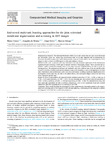Mostrar o rexistro simple do ítem
End-To-End Multi-Task Learning Approaches for the Joint Epiretinal Membrane Segmentation and Screening in OCT Images
| dc.contributor.author | Gende, M. | |
| dc.contributor.author | Moura, Joaquim de | |
| dc.contributor.author | Novo Buján, Jorge | |
| dc.contributor.author | Ortega Hortas, Marcos | |
| dc.date.accessioned | 2022-06-29T18:21:07Z | |
| dc.date.available | 2022-06-29T18:21:07Z | |
| dc.date.issued | 2022 | |
| dc.identifier.citation | GENDE, Mateo, MOURA, Joaquim de, NOVO, Jorge and ORTEGA, Marcos, 2022. End-to-end multi-task learning approaches for the joint epiretinal membrane segmentation and screening in OCT images. Computerized Medical Imaging and Graphics. 2022. Vol. 98, p. 102068. DOI https://doi.org/10.1016/j.compmedimag.2022.102068 | es_ES |
| dc.identifier.uri | http://hdl.handle.net/2183/31041 | |
| dc.description | Financiado para publicación en acceso aberto: Universidade da Coruña/CISUG | es_ES |
| dc.description.abstract | [Abstract] Background and objectives The Epiretinal Membrane (ERM) is an ocular disease that can cause visual distortions and irreversible vision loss. Patient sight preservation relies on an early diagnosis and on determining the location of the ERM in order to be treated and potentially removed. In this context, the visual inspection of the images in order to screen for ERM signs is a costly and subjective process. Methods In this work, we propose and study three end-to-end fully-automatic approaches for the simultaneous segmentation and screening of ERM signs in Optical Coherence Tomography images. These convolutional approaches exploit a multi-task learning context to leverage inter-task complementarity in order to guide the training process. The proposed architectures are combined with three different state of the art encoder architectures of reference in order to provide an exhaustive study of the suitability of each of the approaches for these tasks. Furthermore, these architectures work in an end-to-end manner, entailing a significant simplification of the development process since they are able to be trained directly from annotated images without the need for a series of purpose-specific steps. Results In terms of segmentation, the proposed models obtained a precision of 0.760 ± 0.050, a sensitivity of 0.768 ± 0.210 and a specificity of 0.945 ± 0.011. For the screening task, these models achieved a precision of 0.963 ± 0.068, a sensitivity of 0.816 ± 0.162 and a specificity of 0.983 ± 0.068. The obtained results show that these multi-task approaches are able to perform competitively with or even outperform single-task methods tailored for either the segmentation or the screening of the ERM. Conclusions These results highlight the advantages of using complementary knowledge related to the segmentation and screening tasks in the diagnosis of this relevant pathology, constituting the first proposal to address the diagnosis of the ERM from a multi-task perspective. | es_ES |
| dc.description.sponsorship | This research was funded by Instituto de Salud Carlos III, Government of Spain, [grant number DTS18/00136]; Ministerio de Ciencia e Innovación y Universidades, Government of Spain, [grant number RTI2018-095894-B-I00]; Ministerio de Ciencia e Innovación, Government of Spain through the research project with [grant number PID2019-108435RB-I00]; Consellería de Cultura, Educación e Universidade, Xunta de Galicia, Grupos de Referencia Competitiva, [grant number ED431C 2020/24], Predoctoral grant [grant number ED481A 2021/161] and Postdoctoral grant [grant number ED481B 2021/059]; Axencia Galega de Innovación (GAIN), Xunta de Galicia, [grant number IN845D 2020/38]; CITIC, Centro de Investigación de Galicia [grant number ED431G 2019/01], receives financial support from Consellería de Educación, Universidade e Formación Profesional, Xunta de Galicia, through the ERDF (80%) and Secretaría Xeral de Universidades (20%). The funding sources had no role in the development of this work. Funding for open access charge: Universidade da Coruña/CISUG | es_ES |
| dc.description.sponsorship | Xunta de Galicia; ED431C 2020/24 | es_ES |
| dc.description.sponsorship | Xunta de Galicia; ED481A 2021/161 | es_ES |
| dc.description.sponsorship | Xunta de Galicia; ED481B 2021/059 | es_ES |
| dc.description.sponsorship | Xunta de Galicia; IN845D 2020/38 | es_ES |
| dc.description.sponsorship | Xunta de Galicia; ED431G 2019/01 | es_ES |
| dc.language.iso | eng | es_ES |
| dc.publisher | Elsevier | es_ES |
| dc.relation | info:eu-repo/grantAgreement/ISCIII/Plan Estatal de Investigación Científica y Técnica y de Innovación 2013-2016/DTS18%2F00136/ES/PLATAFORMA ONLINE PARA PREVENCION Y DETECCION PRECOZ DE ENFERMEDAD VASCULAR MEDIANTE ANALISIS AUTOMATIZADO DE INFORMACION E IMAGEN CLINICA/ | |
| dc.relation | info:eu-repo/grantAgreement/AEI/Plan Estatal de Investigación Científica y Técnica y de Innovación 2017-2020/RTI2018-095894-B-I00/ES/DESARROLLO DE TECNOLOGIAS INTELIGENTES PARA DIAGNOSTICO DE LA DMAE BASADAS EN EL ANALISIS AUTOMATICO DE NUEVAS MODALIDADES HETEROGENEAS DE ADQUISICION DE IMAGEN OFTALMOLOGICA/ | |
| dc.relation | info:eu-repo/grantAgreement/AEI/Plan Estatal de Investigación Científica y Técnica y de Innovación 2017-2020/PID2019-108435RB-I00/ES/CUANTIFICACION Y CARACTERIZACION COMPUTACIONAL DE IMAGEN MULTIMODAL OFTALMOLOGICA: ESTUDIOS EN ESCLEROSIS MULTIPLE/ | |
| dc.relation.uri | https://doi.org/10.1016/j.compmedimag.2022.102068 | es_ES |
| dc.rights | Atribución-NoComercial-SinDerivadas 4.0 Internacional | es_ES |
| dc.rights.uri | http://creativecommons.org/licenses/by-nc-nd/4.0/ | * |
| dc.subject | Computer-aided diagnosis | es_ES |
| dc.subject | Optical coherence tomography | es_ES |
| dc.subject | Epiretinal membrane | es_ES |
| dc.subject | Deep learning | es_ES |
| dc.subject | Multi-task learning | es_ES |
| dc.title | End-To-End Multi-Task Learning Approaches for the Joint Epiretinal Membrane Segmentation and Screening in OCT Images | es_ES |
| dc.type | info:eu-repo/semantics/article | es_ES |
| dc.rights.access | info:eu-repo/semantics/openAccess | es_ES |
| UDC.journalTitle | Computerized Medical Imaging and Graphics | es_ES |
| UDC.volume | 98 | es_ES |
| UDC.startPage | 102068 | es_ES |
| dc.identifier.doi | 10.1016/j.compmedimag.2022.102068 |
Ficheiros no ítem
Este ítem aparece na(s) seguinte(s) colección(s)
-
GI-VARPA - Artigos [76]






